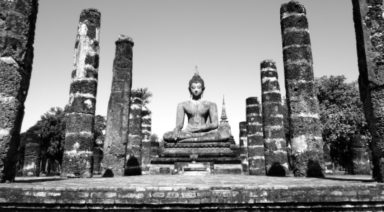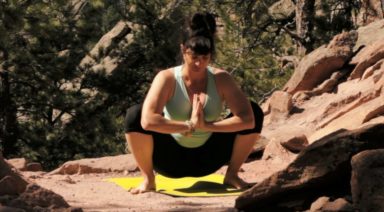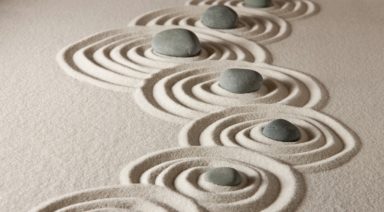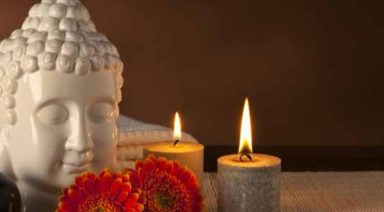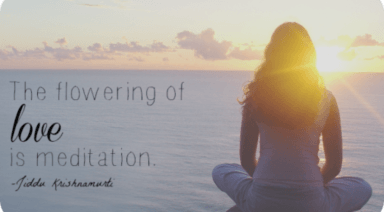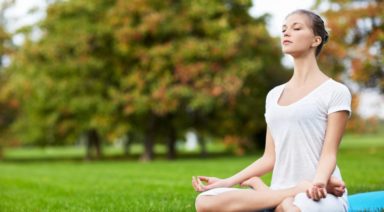3 Breathing Techniques To Unite Mind & Body

“The mind is the king of the senses, and the breath is the king of the mind.” -Hatha Yoga Pradipka
It was only until I discovered yoga years ago that I started to learn how to breathe properly. First off, I noticed how much I took my breath for granted. It was years of breathing in second-hand smoke as a child and suffering from depression and weight gain, etc. before I realized there was more to my breath than struggle and strife.
There are so many powerful breathing techniques (Pranayama in Sanskrit) that can treat myriad maladies, from depression to mental clarity, energy levels, and weight loss; the list goes on and on.
3 Pranayama that will help unite you in mind and body:
4-Point Yogic Breath
This breathing technique helps open the channel of the energy of the entire spine (Shushumna) and helps to clear blockages, energy spots along the spine (chakras) and the abdominal region, as well as increasing lung capacity. This technique also aids in weight loss, as you focus on bringing energy into the stomach and lungs.
- Sit up straight in a comfortable seated position
- Place your left hand on your belly and right hand on your chest. Breathe in through the nose, filling the belly first then expanding into the chest second.
- Exhale, starting with the chest and then stomach, creating a rippling wave through the hands as they rise and fall with your breath. The whole torso is breathing belly-chest, chest-belly, creating a 4-pointed yogic breath.
Alternate Nostril Breathing (Nadi Shodhana)
These breathing techniques calm the mind, bringing you sensations of happiness and peace. A few minutes of pranayama per day is best to destress the mind, releasing tension and fatigue. It’s named Nadi Shodhana Pranayama (NAH-dee sho-DAH-nah prah-nah-YAH-mah), as it helps clear out blocked energy channels in the body, which in turn calms the mind (nadi = subtle energy channel, shodhana = purifications, pranayama = breathing technique).
Sit comfortably with your spine erect and shoulders relaxed. Keep a gentle smile on your face and close your eyes.
- Place your left hand on the left knee, palms open to the sky or in Chin Mudra (thumb and index finger gently touching at the tips).
- Place the tip of the index finger and middle finger of your right hand in between the eyebrows, the ring finger and little finger on the left nostril, and the thumb on the right nostril. We will use the ring finger and little finger to open or close the left nostril and thumb for the right nostril.
- Press your thumb down on the right nostril and breathe out gently through the left nostril.
- Now breathe in from the left nostril and then press the left nostril gently with the ring finger and little finger. Removing the right thumb from the right nostril, breathe out from the right. Start 5 to 5 count inhales to exhales and work towards doubling exhale out.
- Breathe in from the right nostril and exhale from the left. You have now completed one round. Continue inhaling and exhaling from alternate nostrils.
- Complete nine rounds by alternately breathing through both the nostrils. After every exhalation, remember to breathe in from the same nostril from which you exhaled. Keep your eyes closed throughout and continue taking long, deep, smooth breaths without any force or effort.
Skull-shining Breath (Kapalabhati)
Kapalabhati Pranayama (kah-pah-luh-BAH-tee prah-nah-YAH-mah) is an intermediate-to-advanced technique that consists of short, powerful exhales and passive inhales. This exercise is a traditional internal purification practice, or kriya, that tones and cleanses the respiratory system by encouraging the release of toxins and waste matter (Kapala = skull, Bhati = light). It helps to cleanse the lungs, sinuses and respiratory system, which can help to prevent illness and allergies. Regular practice strengthens the diaphragm and abdominal muscles.
To begin, sit in a comfortable position where your spine is straight and your abdomen is not compressed. Some options include sitting upright in easy pose, on your heels in hero’s pose, or seated in a chair with your feet flat on the floor.
- Rest your hands on your knees, palms facing down.
- Bring your awareness to your lower belly. To heighten your awareness, you can place your hands, one on top of the other, on your lower belly rather than on your knees.
- Inhale through both nostrils deeply.
- Contract your low belly or use your hands to gently press on this area, forcing out the breath in a short burst.
- As you quickly release the contraction, your inhalation should be automatic and passive — your focus should be on exhaling.
- Begin slowly, aiming for 65-70 contractions per minute. Gradually quicken the pace, aiming for 95-105 exhalation/inhalation cycles per minute. Always go at your own pace and stop if you feel faint or dizzy.
- After one minute of the exercise, inhale deeply through the nostrils, and then exhale slowly through your mouth. Depending on your experience level, you may repeat the exercise.
How to Create a Meditation Altar

In The Miracle of Mindfulness, Zen Master Thich Nhat Hanh says that we should meditate because “each of us needs to realize total rest…mindfulness is the miracle by which we master and restore ourselves.” Sometimes, even a full night’s sleep doesn’t help you achieve total rest. How can the restless truly rest in modern society? Mindfulness, or the art of living in the present moment, is an important state of being to achieve in such a busy world. It’s not only good for your overall well-being, but it’s also an excellent way to practice self-love. Discover how to make a meditation altar designed for your specific spiritual practice.
1. Develop a Daily Meditation Practice
As we rush through life, many of us feel like we’re not quite present in every moment. According to Karen Kissel Wegela, Ph.D., to counter this feeling, practice mindfulness meditation. Meditation allows you to let go when stressed and accept yourself just as you are – your thoughts, feelings, and emotions as they arise from moment to moment.
It is important to have a meditation practice that grounds and centers you daily. Such a practice will allow you to feel strongly connected to and centered with yourself. Sometimes, breathing exercises aren’t enough. You need a physical place to go to and rest. While mindfulness meditation can be practiced anywhere, having a sacred space to call your own is important. An altar is a beautiful space full of sacred energy that you can tap into when you need it. Anyone can create an inspirational altar with just a few items and pure intention.




